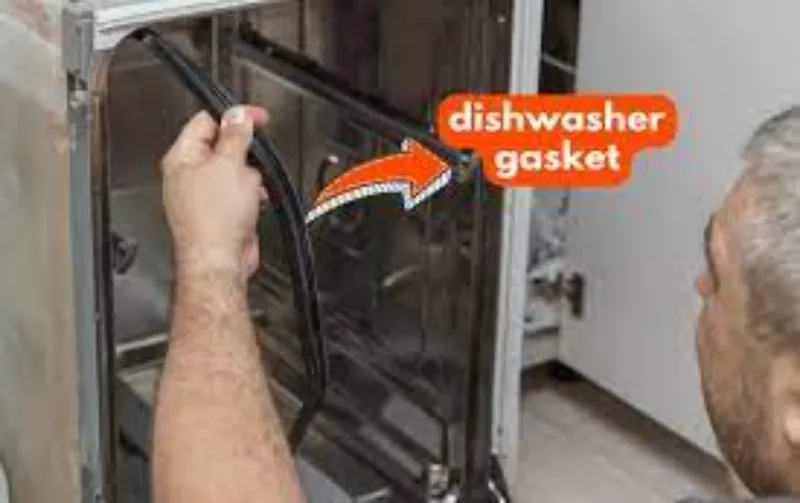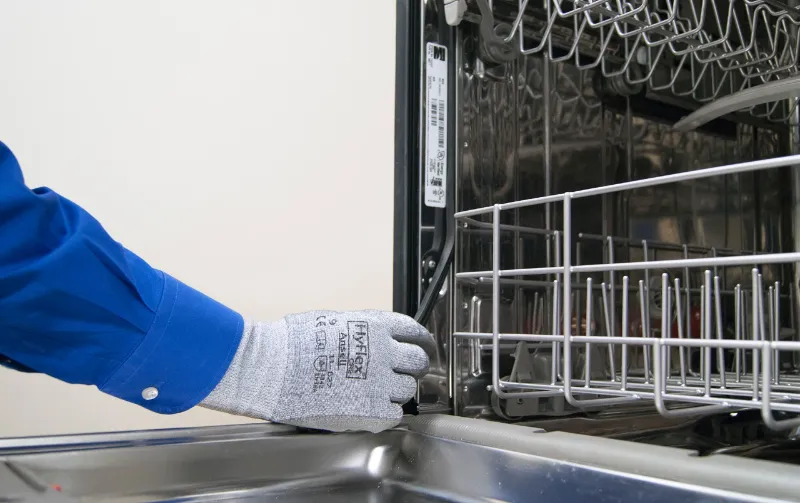A dishwasher gasket is a rubber or plastic seal that prevents water from leaking out of the dishwasher during a wash cycle. It is located around the door or tub and creates a watertight seal when the dishwasher is in use.
The dishwasher gasket is a crucial component that ensures the efficient operation of your dishwasher.
It plays a vital role in preventing water leakage and maintaining the proper functioning of the appliance.
A damaged or worn-out gasket can lead to leaks, which may cause water damage to your kitchen floor or cabinets.
Proper maintenance and timely replacement of the dishwasher gasket are essential to avoid such issues.
Understanding the importance of the dishwasher gasket can help you maintain your appliance and extend its lifespan, saving you from unnecessary expenses and inconvenience.

What Is A Dishwasher Gasket?
When it comes to your dishwasher, ensuring that every component is in top condition is essential for optimal performance.
One often overlooked but crucial part is the dishwasher gasket.
Understanding what a dishwasher gasket is and its function can help in maintaining the efficiency of your appliance.
Function Of A Dishwasher Gasket
A dishwasher gasket, also known as a door seal or door gasket, is a flexible, rubber-like strip that is attached to the dishwasher door.
It serves as a seal between the door and the main body of the dishwasher.
When the dishwasher is in operation, the gasket creates a watertight seal that prevents water from leaking out of the dishwasher.
This crucial component also helps to keep the heat and steam inside the dishwasher during the wash cycle.
Importance Of A Properly Functioning Gasket
A properly functioning gasket is vital for the overall performance and efficiency of your dishwasher.
It not only prevents leaks that can cause water damage to your kitchen but also ensures that the dishwasher’s cleaning and drying functions work effectively.
When the gasket is worn out or damaged, it can lead to water leakage, inefficient cleaning, and even higher energy consumption.
Given its essential role, regular inspection and maintenance of the dishwasher gasket is key to avoiding these potential issues and maximizing the lifespan of your appliance.
Rubber Gaskets
Rubber gaskets are an essential component of a dishwasher, playing a crucial role in creating a watertight seal to prevent leaks.
These gaskets are commonly made of rubber or silicone material and are designed to fit into specific grooves or channels within the dishwasher door or tub.
Characteristics Of Rubber Gaskets
Rubber gaskets possess several key characteristics that make them suitable for use in dishwashers. These characteristics include:
- Flexible and resilient
- Ability to withstand high temperatures
- Excellent sealing properties
- Durable and long-lasting
Pros And Cons Of Rubber Gaskets
When it comes to rubber gaskets in dishwashers, there are various aspects to consider:
| Pros | Cons |
|---|---|
| Effective at preventing water leaks | Potential for wear and tear over time |
| Resistant to detergents and chemicals | May require periodic maintenance or replacement |
| Provides a secure seal for efficient dishwasher operation | Exposure to extreme temperatures can degrade rubber material |
Silicone Gaskets
When it comes to dishwashers, the gasket is an essential component that plays a crucial role in preventing water leakage.
Among the various types of gaskets, silicone gaskets stand out for their unique properties and advantages.
Advantages Of Silicone Gaskets
Silicone gaskets offer several advantages that make them a popular choice for dishwasher applications. Here are some key benefits:
- Excellent heat resistance
- Superior flexibility and elasticity
- Resistance to UV, ozone, and weathering
- Chemical inertness
- Wide temperature range compatibility
How Silicone Gaskets Differ From Rubber Gaskets
While both silicone and rubber gaskets serve similar sealing purposes, they have distinct differences:
| Aspect | Silicone Gaskets | Rubber Gaskets |
|---|---|---|
| Heat Resistance | Excellent | Good, but lower than silicone |
| Chemical Resistance | High | Depends on the type of rubber |
| Flexibility | High | Varies based on rubber compound |
| Longevity | Durable, longer lifespan | May degrade over time |
Step-by-step Guide For Installation
When it comes to installing a dishwasher gasket, it’s important to follow a step-by-step guide to ensure proper installation.
This will not only help in maximizing the efficiency of your dishwasher but also prevent any leaks and malfunctions.
Tools Required For Installation
- Flathead screwdriver
- Adjustable wrench
- Gasket adhesive
- Clean cloth
PrepaThe Dishwasher For Gasket Installation
Prior to installation, make sure to disconnect the power supply and turn off the water supply to the dishwasher.
Then, open the dishwasher door and locate the gasket. Use a clean cloth to remove any debris or residue from the gasket groove to ensure a clean and smooth surface for installation.
The Gasket Properly
- Start by applying a thin layer of gasket adhesive to the gasket groove, ensuring complete coverage.
- Once the adhesive is applied, carefully press the gasket into the groove, starting from one end and working your way around the entire perimeter of the dishwasher door.
- Use a flathead screwdriver to tuck any excess gasket material into the groove, ensuring a tight seal.
- Finally, close the dishwasher door and allow the adhesive to set as per the manufacturer’s instructions.
Common Installation Mistakes To Avoid
When it comes to installing a dishwasher gasket, there are several common mistakes that many people tend to make.
Avoiding these pitfalls is crucial to ensuring a secure and effective installation.
Pitfalls To Watch Out For During Installation
Making certain mistakes during installation can lead to improper functioning of the dishwasher gasket. It’s important to be mindful of these potential pitfalls:
- Placing the gasket in the wrong position can lead to leaks and inefficiency.
- Applying excessive force while securing the gasket can cause damage and compromise its effectiveness.
- Failing to clean the surface before installation can lead to a poor seal and potential damage to the gasket.
- Ensuring the gasket is properly aligned is crucial for a tight seal and optimal performance.
Tips For Ensuring A Secure And Effective Installation
For a successful installation and optimal performance of the dishwasher gasket, consider the following tips:
- Thoroughly clean the surface where the gasket will be installed to ensure a secure seal.
- Carefully align the gasket in the designated groove to ensure a proper fit.
- Use the specified amount of pressure to secure the gasket without over-tightening.
- Check for any debris or dirt that may affect the seal and remove it before installation.
- Always refer to the manufacturer’s instructions for specific installation steps and recommendations.

Cleaning And Maintenance
A dishwasher gasket is an essential part of the dishwasher that helps to create a watertight seal around the door, preventing leaks and ensuring optimal performance.
Cleaning and maintaining the gasket is crucial to prolong its lifespan and prevent potential issues.
Best Practices For Cleaning Gaskets
To ensure the optimal performance and longevity of your dishwasher gasket, regular cleaning is essential. Follow these best practices to effectively clean the gasket:
- Check the gasket for any visible signs of dirt, mold, or debris accumulation.
- Use a mild solution of water and detergent to gently clean the gasket, avoiding harsh chemicals that may degrade the material.
- Use a soft-bristled brush or cloth to gently scrub the gasket and remove any stubborn residues.
- After cleaning, ensure the gasket is thoroughly dried to prevent the growth of mold and mildew.
Preventive Maintenance To Extend Gasket Lifespan
In addition to regular cleaning, taking preventive maintenance measures can significantly extend the lifespan of the dishwasher gasket.
Consider the following preventive maintenance practices:
- Avoid slamming the dishwasher door, as this can put unnecessary strain on the gasket.
- Regularly inspect the gasket for any signs of wear, tear, or damage, and replace it if necessary.
- Overloading the dishwasher can put excessive pressure on the gasket, leading to premature wear and tear.
- Refrain from using abrasive or harsh chemicals that may deteriorate the gasket material over time.
Troubleshooting Gasket Issues
Signs Of Gasket Wear Or Damage
A dishwasher gasket plays a crucial role in ensuring a tight seal around the appliance door, preventing leaks, and maintaining energy efficiency.
Over time, wear and tear can lead to gasket issues that may compromise the dishwasher’s performance.
Identifying signs of gasket wear or damage is essential for maintaining the appliance’s functionality.
Steps To Address Common Gasket Problems
- Ensure to inspect the gasket regularly to identify any signs of wear, tearing, or stretching.
- Gently clean the gasket with mild soap and water to remove any buildup or debris that could impact its effectiveness.
- Proper alignment of the gasket is crucial, so ensure it is properly positioned and not misaligned, which could cause leaks.
- Replace if necessary: If the gasket shows signs of significant wear or damage, consider replacing it to restore the dishwasher’s efficiency.
Tips For Prolonging Gasket Lifespan
When it comes to your dishwasher, the gasket plays a crucial role in preventing leaks and ensuring effective sealing of the unit.
Proper care and maintenance routines are essential for keeping the dishwasher gasket in good condition, minimizing the risk of potential issues.
Here are some tips for prolonging the gasket lifespan and maintaining the efficiency of your dishwasher.
Proper Care And Maintenance Routines
Proper care and maintenance of the dishwasher gasket are essential for extending its lifespan. Here are some effective care and maintenance routines to follow:
- Keep the gasket clean by wiping it with a damp cloth to remove any debris or buildup. This prevents deterioration and maintains the flexibility of the material.
- Regularly inspect the gasket for any signs of wear, tear, or damage. If you notice any cracks or gaps, consider replacing the gasket to prevent leaks.
- Use mild, non-abrasive cleaners to avoid damaging the gasket material. Harsh chemicals can cause deterioration, leading to a shorter lifespan.
- When replacing the gasket, ensure it is properly installed to form a tight seal around the door. This prevents water from leaking out during the dishwashing cycle.
How To Detect And Prevent Potential Issues With Gaskets
Detecting and preventing potential issues with gaskets is essential to avoid costly repairs and water damage.
Here are some tips to help you maintain the gasket and prevent potential issues:
- Ensure the gasket is properly aligned and free of any obstructions that could prevent it from sealing effectively.
- Keep the gasket dry and remove any moisture or standing water to prevent mold and mildew growth, which can affect the gasket’s integrity.
- Apply a silicone-based lubricant to the gasket to keep it supple and prevent it from drying out or cracking.
- Avoid overloading the dishwasher, as excessive pressure from overcrowding can affect the gasket’s ability to form a tight seal.
Frequently Asked Questions For What Is A Dishwasher Gasket
What Is A Dishwasher Gasket?
A dishwasher gasket is a rubber seal that prevents water leakage around the dishwasher door.
How Often Should A Dishwasher Gasket Be Replaced?
It is recommended to replace the dishwasher gasket every 1-2 years to ensure an effective seal.
What Are The Signs Of A Faulty Dishwasher Gasket?
Signs of a faulty gasket include water leakage, moldy odors, and visible wear or damage.
Can I Replace A Dishwasher Gasket Myself?
Yes, you can easily replace a dishwasher gasket by following the manufacturer’s instructions or seeking professional help if needed.
Conclusion
In short, the dishwasher gasket is a vital component that prevents leaks in your appliance.
By regularly inspecting and maintaining the gasket, you can avoid costly water damage and ensure the efficient operation of your dishwasher.
Remember, a small gasket can make a big difference in your kitchen.
